|
Report
from
Europe
Improvement in economic sentiment in Europe, but conditions very
fragile
Economic sentiment in Europe improved a little during the second quarter
of 2013. Talk of a possible ¡°depression¡± and euro-collapse has receded
into the background.
Nevertheless overall economic conditions remain fragile and the
construction sector, the major driver of wood demand, is still deep in
negative territory.
GDP data for the first quarter of 2013 reveals that the EU economy
remained static at the depressed level achieved in the last quarter of
2012.
Slow growth in Germany and UK during the quarter was offset by
continuing decline in France, Italy and other southern European
countries.
Nevertheless, the European Commission was sufficiently encouraged by the
figures to revise upwards their forecast for EU GDP change during 2013
from -0.3% to -0.1%. For 2014, economic activity is now projected to
expand by 1.4% in the EU.
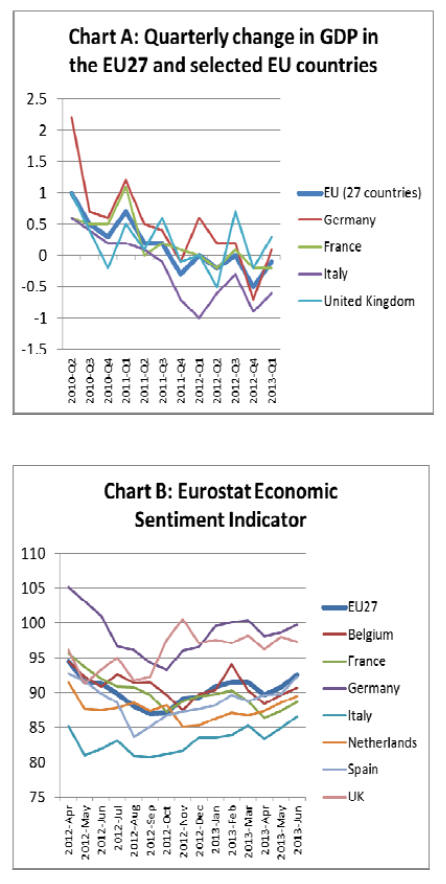
The Economic Sentiment Index (ESI) showed some improvement in the second
quarter of 2013 both for the EU as a whole and for many individual EU
countries (Chart B).
However, the index remains well below 100 in nearly all EU countries.
This means that a majority of those surveyed are still not optimistic
that market conditions will improve in the short term. Germany and the
UK continue to stand out as countries where there is a higher level of
confidence about future prospects.
The Citigroup Eurozone Economic Surprise Index fell very sharply between
the end of February and end of May.
This index tries to capture how well the data is coming in relative to
economic expectations. At the end of February 2013, the index stood at
+70 as most data was exceeding expectations at that time.
However the index fell like a stone to -53.2 at the end of May 2013.
This was due to publication of a relentless series of very poor numbers
across the euro-zone on economic growth, employment, manufacturing,
industrial production, and retail sales.
The CESI improved a little in June 2013. However the index has yet to
establish a meaningful upward trend.
Indicators relating to the construction sector, of most direct relevance
to wood consumption, remain very negative. The Construction Confidence
Index was flat at -30 during the first 6 months of 2013 (Chart C).
This shows that construction professionals are very pessimistic about
the likelihood of an upturn any time soon.
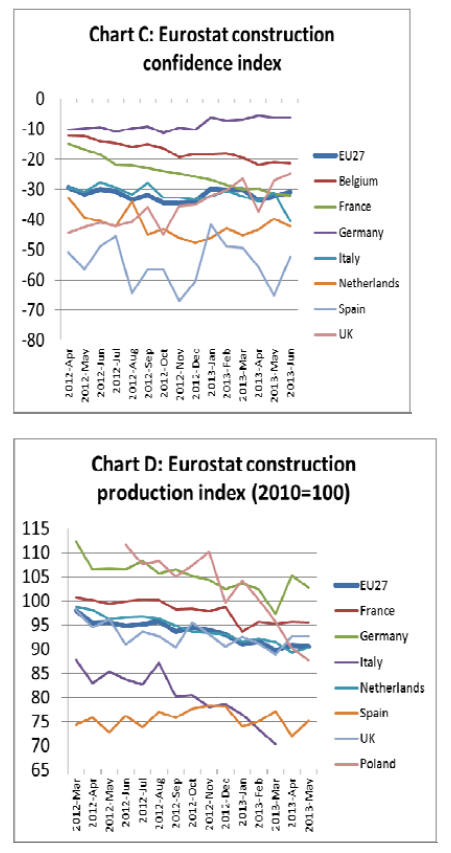
The European Construction Production Index, which measures actual output
in the sector, declined continuously between 2010 and March 2013 and
remained flat at a low level in April and May 2013 (Chart D).
Construction output across the EU in the first 5 months of 2013 was only
90% of the depressed levels registered in 2010.
The latest data for the EU Building Permits Index shows there was a very
sharp fall in the number of construction permits issued across the EU in
the last quarter of 2012 and that permits remained at a low level in the
first quarter of 2013 (Chart E).
This strongly reinforces the view that construction activity is likely to
be even weaker during 2013 than in the previous year. Building permits
remain at historically very low levels in Spain, Netherlands, and Italy
and have declined sharply in Poland.
However, building permits have remained robust in Germany and recovered
slightly in France during the first quarter of 2013.
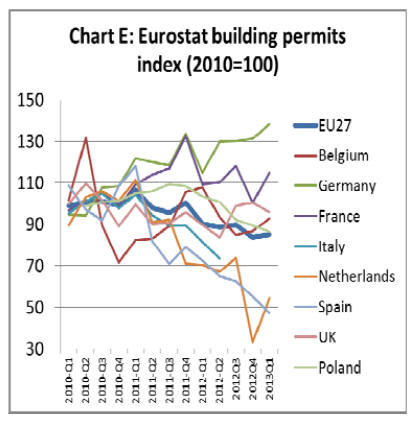
European parquet flooring consumption weakens once more
At their annual meeting in June, the Federation of the European
Parquet Industry (FEP) reported that wood flooring production in FEP
member countries declined in 2012 by 4.7% to 68.3 million m2 (Chart F).
This reversal meant that production in 2012 was no more than in 2009 at
the height of the global financial crises. Production increased a little
in Poland, Germany and Austria last year, but weakened in Sweden,
France, Spain and Italy.
Consumption in FEP member countries followed a similar trend, declining
5.9% to 87.5 million m2 during 2012 (Chart F). Again this was a
turnaround after two years of recovery in 2010 and 2011 and consumption
in 2012 barely exceeded that of 2009.
German and Austrian consumption continued to recover in 2012, but
consumption fell sharply into Spain and Italy and also weakened in
France, Scandinavia and Switzerland.
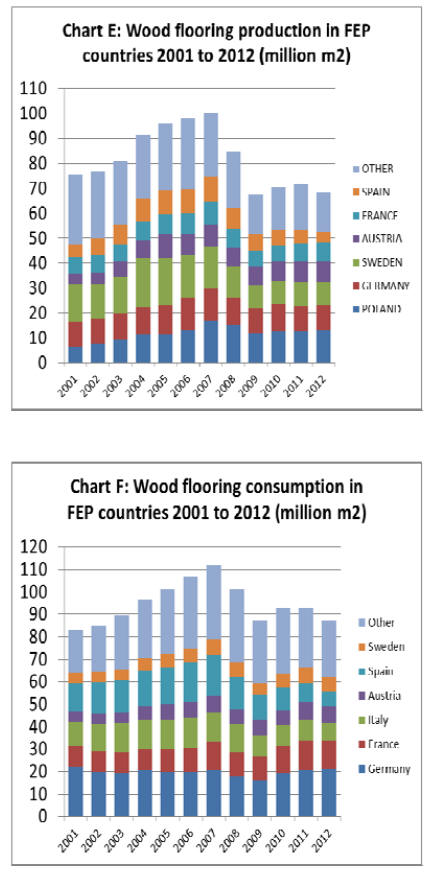
There was little change in the proportion of wood flooring output by
product type between 2011 and 2012 (Chart G).
Multi-layer flooring continued to dominate, accounting for 78% of the
volume of all wood flooring manufactured in FEP member countries during
2012. Solid wood flooring accounted for 21% of production volume and
mosaic flooring for 2% in 2012.
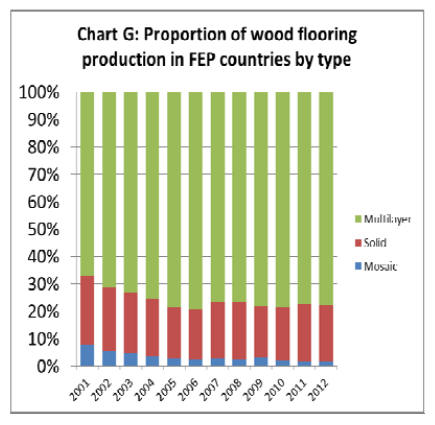 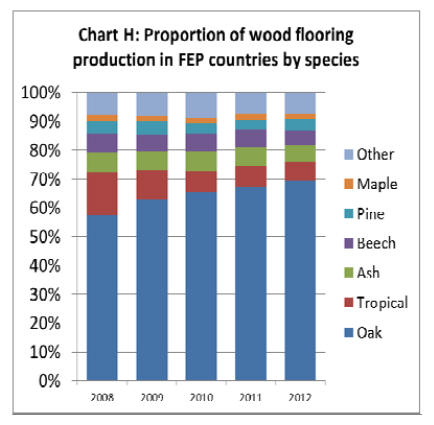
The most obvious trend in species usage during 2012 was a further increase
in oak¡¯s dominance, mainly at the expense of tropical hardwood. In 2012,
oak accounted for 70% of all flooring production in FEP member
countries, up from 58% in 2008. In the last five years, share of
tropical wood has declined from 15% to 6%.
Over the same period, share of temperate species other than oak has
fallen from 28% to 24%. These include ash, beech, pine, and maple in
descending order of importance.
The increasing domination of oak is explained by a combination of:
consumer preference for a species perceived to be full of character and
of ¡°high quality¡±; the development of a wide range of new staining and
other treatment techniques that have hugely increased the range of looks
that can be achieved with oak; wide availability from domestic and North
America sources; rising prices and declining availability of tropical
hardwoods; and environmental campaigns targeting tropical hardwoods.
European laminated flooring sector suffering from over-capacity and
competition
Europe¡¯s laminated flooring sector, while still dominant in global
terms, has been struggling during the global financial crises.
In addition to declining consumption, the sector has come under intense
competitive pressure from manufacturers in other parts of the world,
particularly China.
The laminate flooring sector is also suffering from overcapacity which
has put considerable pressure on prices. While consumers benefit from
very low prices, retailers now need to shift huge volumes in order to
profit from sales of laminate flooring.
As a result distributors are looking for higher margin products. At
present there¡¯s growing interest in Luxury Vinyl Tiles (LVT) which are
increasingly viewed as offering a better combination of quality, value
and margin.
The European laminate flooring industry is responding, partly through
down-sizing, partly through development of new higher value product
lines, and partly through marketing efforts emphasising the specific
performance and environmental benefits of laminate flooring. The
laminate market has become split between the low-end product selling for
less than euro 10 per square meter and the upscale product that offers
bevelled edges, hand scraping, wire brushing and exotic designs priced
in excess of €20 per square meter.
At their annual meeting in June 2013, the Association of European
Producers of Laminate Flooring (EPLF) discussed the global laminate
market noting that, in their estimation, China recently overtook Germany
as the largest single manufacturer of laminate flooring in the world.
EPLF estimate that of total global production of around 870 million m2
in 2012, China contributed 243 million m3 (28%) and Germany 234 million
m2 (27%). However taken together, the 22 member companies of the EPLF
(all located in Europe including Turkey) accounted for 460 million m2 in
2012, 53% of global production (Chart I).
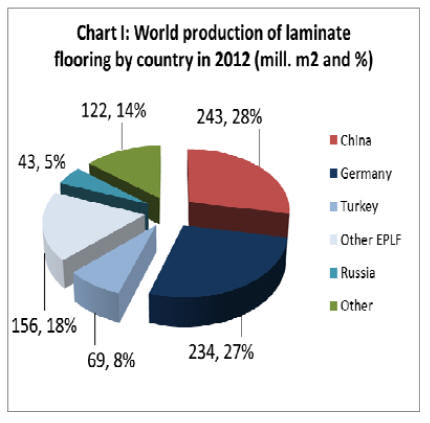
EPLF data shows that sales of laminated flooring by EPLF members fell
sharply during 2011 and 2012 (Table). During these years, low and
declining sales in Europe and North America were only been partially
offset by increased sales to Turkey, Latin America, Asia and Russia.
During the first quarter of 2013, overall global sales by EPLF members
stabilised at the lower level achieved in 2012.
This year sales have continued to decline in Germany, France, the UK,
the Netherlands, Spain, Austria, and the USA. However rising sales in
Sweden, Italy, Latin America and Asia have been just sufficient to
offset weak markets elsewhere.
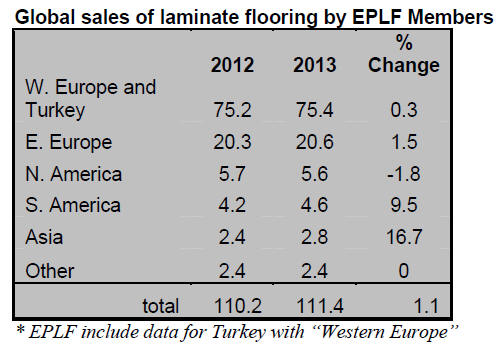
In 2012, for the first time, EPLF members also provided sales figures by
product thickness. Around 45% of all EPLF laminate flooring sales were
products with a thickness of less than 7.5mm, around 45% were 8mm to 9mm
thick and the remaining 10% had thickness in excess of 10 mm.
Products 8mm to 9mm thick are the biggest sellers in Eastern Europe and
Turkey. In Western Europe, and Germany in particular, customers prefer
products which are thinner than 7.5mm.
European laminate producers complain about Chinese competitors in
Russia
Competition in the laminate flooring market is intense in all
regions. However, EPLF expressed particular concern about competition
from Chinese manufacturers in Russia in a press statement issued after
their June meeting:
¡°It is with some concern that the EPLF is seeing the Russian laminate
flooring market being flooded with mass produced Chinese goods, which
also do not meet high European standards. There is a risk that these
products will damage the reputation of laminate flooring amongst Russian
customers. The EPLF has therefore decided to initiate a quality campaign
to raise awareness of the high-quality products of European
manufacturers and to distance itself from inferior cheap products¡±.
The statement goes on to claim that European laminate flooring products
¡°are environmentally-friendly, high-tech products, manufactured in a
sustainable manner. In other words, they are gentle on resources and
socially responsible. European quality is synonymous with long-lasting
floors, innovative products for enhanced interior comfort, leading
design for versatility and individuality, good value for money and,
importantly, ecologically-sound products which guarantee safety for
customers and their families¡±.
Mounting challenge from ¡°Luxury Vinyl Tiles¡±
Laminate flooring is under intensifying competitive pressure from LVT.
Made primarily from polyvinyl chloride resins and plasticizers, LVT is
being heavily promoted as a versatile, relatively low cost but
nevertheless ¡°luxury¡± product. LVT manufacturers and retailers claim it
offers good cleaning and maintenance, easy installation, good acoustics
and high levels of durability.
It¡¯s also claimed that new decorative films for LVT take advantage of
higher-resolution ¡®HD¡¯ printing and other technologies to produce
increasingly realistic wood, stone and tile looks covering a myriad of
designs and textures.
In countering the threat from LVT, the wood laminates industry is
placing considerable emphasis on the relative environmental benefits of
a wood-based flooring product.
European laminates manufacturers now make far-reaching claims that
products are made exclusively from either wood sourced from sustainably
managed domestic forests, or recycled material from the timber industry.
Even the decorative finishes are being printed on certified paper with a
high proportion of recycled material and natural water-based inks. They
are using eco-friendly resins as binder and increasing use of recycled
paper to make packaging.
They claim that laminate flooring manufactured in Europe is low-emission
and far outperforms legal limits for formaldehyde and VOCs (volatile
organic compounds).
To back these claims, European laminate manufacturers are investing in
Environmental Product Declarations (EPDs). Most laminate flooring
manufactured by EPLF members now comes with an EPD prepared in line with
the ISO14025 standard for "Environmental labels and declarations".
Laminate design trends
The ¡°wood look¡± remains very dominant in the laminate flooring sector
comprising perhaps 80% of all sales. Amongst wood types, the laminates
sector follows the ¡°real wood¡± sector so far as oak is the preferred
look.
According to EPLF ¡°Oak is always popular with designers. No other
laminate flooring decor offers as many different possibilities as this
expressive domestic timber that has been a dominant mainstream player
over the last few years - and will continue to be so.
Natural, light shades, very rustic textures, subtly altered vintage
looks - oak offers an impressive range of possible designs¡±.
However, the laminates sector is also trying to differentiate itself
from the ¡°real wood¡± sector by emphasising its ability to offer a huge
variety of ¡°experimental timber looks¡±.
Increasingly radical designs are being promoted which combine the grain
of different wood species with unusual and bold colours and other
decorative features. The laminates sector is exploiting its ability to
offer a much wider range of board lengths and widths at competitive
prices than for the real wood product.
There¡¯s also much emphasis in the sector on improving the texture and feel
of laminate flooring to produce a more ¡°authentic¡± look. This is of
increasing concern to modern architects and consumers and one factor
that continues to give real wood a genuine competitive edge.
* The market information above has been generously provided by the
Chinese Forest Products Index Mechanism (FPI)
|